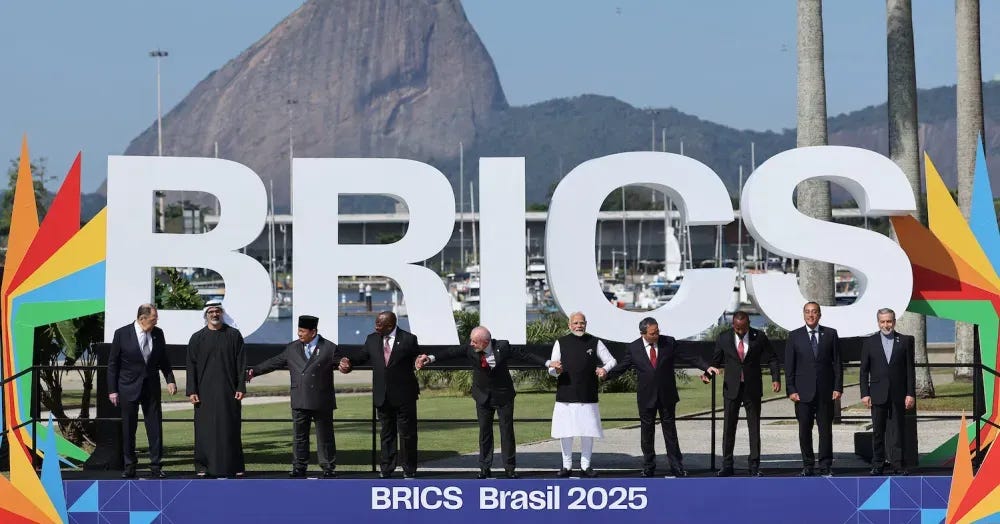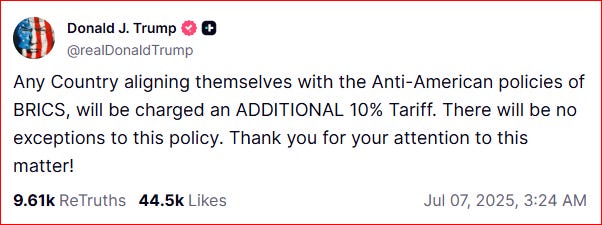BRICS vs. Trump: What the 2025 Summit Reveals
Discover how trade threats, dollar dominance, and strategic hedging at the BRICS 2025 Summit reveal the fault lines shaping the future of the organization.

The 2025 BRICS summit in Rio de Janeiro illuminated with unusual clarity the structural tensions confronting a coalition of emerging powers seeking greater strategic latitude within an international order still anchored in U.S. economic, financial, and institutional dominance.
The event's muted atmosphere, manifested in the conspicuous absence of Chinese President Xi Jinping and Russian President Vladimir Putin (both central figures in the bloc’s geopolitical heft), underscored the degree to which participating states calibrated their behavior in response to tangible constraints rather than rhetorical aspirations.
The carefully worded communiqué, which offered little beyond reaffirmations of prior commitments to multilateral cooperation, revealed how deeply material interdependencies, particularly with the United States, and the threat of economic coercion shape multilateral conduct.
The restraint on display did not reflect diminished ambition but a pragmatic calculation: in a world where hegemonic power is exercised through institutional dominance and the implicit threat of economic reprisal, deviation from the status quo carries concrete costs.
The structure and content of the summit were determined by a pervasive wariness of incurring retaliatory measures from Washigton. This caution was grounded in the asymmetric vulnerability of BRICS member economies to disruptions originating in U.S.-controlled financial and trade systems (networks that include the global dominance of the U.S. dollar, preferential access to U.S. consumer markets, and reliance on U.S.-regulated banking channels).
The deliberate choice to refrain from explicitly naming the United States in critiques, despite unmistakable references to U.S. tariffs and military interventions, exemplifies a shared risk-averse posture.
U.S. President Donald Trump’s tariff threats, delivered through social media with immediate global visibility, operated as signaling devices intended not only to discipline BRICS members but also to warn potential partner states that alignment with initiatives perceived as counter to U.S. interests would incur real economic penaltiees.
The moderation exhibited by Brazil and India, both of which actively avoided direct confrontation with Washington despite their vocal support for a multipolar international system, exposed a fundamental contradiction at the heart of BRICS: the divergence between political aspiration and structural constraint.
While Brazil and India are central to the bloc’s push for institutional reform and broader geopolitical relevance, their economic strategies remain deeply tethered to Western capital flows, export markets, and investment regimes. As a result, these states engage in what is best described as hedging, an approach that seeks to expand diplomatic options and institutional partnerships while avoiding commitments that might provoke retaliatory measures.
The bloc’s recent expansion, while nominally a sign of increased relevance, has further amplified this tension. The inclusion of states with conflicting priorities and varying degrees of Western engagement (such as overt U.S. adversaries like Iran alongside more neutral actors like Indonesia) has introduced additional centrifugal pressures that complicate coherent bloc-wide policymaking.
The summit’s public messaging, which emphasized areas such as economic development, artificial intelligence governance, and technical cooperation, functioned less as a roadmap for strategic realignment and more as a tactical buffer against economic backlash. These themes, carefully curated to appear constructive and non-confrontational, enabled BRICS to pursue institutional visibility without provoking direct confrontation with the United States.
The mere discussion of alternative payment systems within the bloc triggers aggressive rhetoric from Washington. This response underscores the degree to which the maintenance of dollar hegemony remains a non-negotiable strategic objective for the United States. Any signal of deviation, however symbolic or tentative, invites preventive measures designed to safeguard the existing financial order.
This logic of anticipatory containment defines the current phase of U.S. economic statecraft, wherein the threat of punishment serves to disincentivize experimentation with parallel sysstems.
The asymmetric treatment of geopolitical conflicts in the summit’s final declaration, explicit condemnation of Israeli actions in Gaza coupled with the absence of criticism of Russian operations in Ukraine, highlighted the bloc’s selective engagement with contentious international issues.
This selectivity is indicative of a strategic balancing act necessitated by internal diversity and external exposure. Many BRICS members must simultaneously manage alliances with Russia and economic relations with the West, rendering any unified stance on conflicts involving these actors nearly impossible.
The criticism of NATO’s defense spending and accusations of fueling a global arms race, led by Brazilian President Luiz Inácio Lula da Silva, extended this pattern. By framing military escalation as a symptom of systemic failure in multilateral governance, these remarks articulated a critique of Western security structures without directly implicating specific NATO members, an approach that preserved plausible deniability while reinforcing the bloc’s opposition to the securitization of global development.
Trump’s persistent use of tariffs and trade policy as instruments of geopolitical leverage reveals a broader strategy aimed at delegitimizing the concept of multialignment: the pursuit of diversified strategic partnerships by states outside the traditional Western orbit. By labeling BRICS as inherently “anti-American,” Trump seeks to transform what is, in practice, a fragmented and pragmatically oriented bloc into a binary antagonist within a revived Cold War framework.
This framing is not intended to reflect geopolitical reality but to serve a deterrent function. By making alignment with BRICS appear synonymous with economic risk, the United States elevates the cost of
Keep reading with a 7-day free trial
Subscribe to Horizon Geopolitics to keep reading this post and get 7 days of free access to the full post archives.








